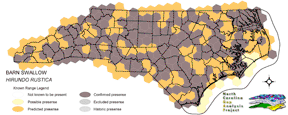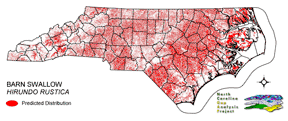
| Taxa: |
| Order: |
| Family: |
| Aves |
| Passeriformes |
| Hirundinidae |
| NatureServe Global Rank: |
| NatureServe State (NC) Rank: |
| G5 |
| S5B,SZN |
| Federal Status: |
| NC State Status: |
| --- |
| --- |


| Land Unit |
| US Fish & Wildlife Service |
| US Forest Service |
| US National Park Service |
| US Department of Defense |
| NC State Parks |
| NC University System |
| NC Wildlife Res. Com. |
| NC Forest Service |
| NC Div. of Coastal Mgmt. |
| Local Governments |
| Non-Governmental Org. |
| Other Public Lands |
| Private Lands |
| GAP Status 1-2 |
| All Protected Lands |
| Statewide |
| Hectares |
| 26,114.67 |
| 17,238.33 |
| 23,481.00 |
| 15,351.57 |
| 4,529.61 |
| 1,075.14 |
| 11,090.07 |
| 1,104.03 |
| 2,079.36 |
| 1,690.65 |
| 4,231.35 |
| 3,177.45 |
| 4,359,715.92 |
| 54,335.70 |
| 107,551.44 |
| 4,470,879.15 |
| Acres |
| 64,530.74 |
| 42,596.83 |
| 58,022.80 |
| 37,934.55 |
| 11,192.91 |
| 2,656.73 |
| 27,404.15 |
| 3,010.56 |
| 5,138.21 |
| 4,177.69 |
| 10,455.89 |
| 7,851.65 |
| 10,773,090.56 |
| 134,548.85 |
| 266,047.79 |
| 11,048,063.27 |
| % of Dist. on |
| Prot. Lands |
| 24.3 % |
| 16.0 % |
| 19.9 % |
| 14.3 % |
| 4.2 % |
| 1.0 % |
| 9.8 % |
| 1.0 % |
| 1.9 % |
| 3.8 % |
| 3.8 % |
| 2.4 % |
| < 0.1 % |
| 50.5 % |
| ----- |
| ----- |
| % of Dist. on |
| All Lands |
| 0.6 % |
| 0.4 % |
| 0.5 % |
| 0.3 % |
| 0.1 % |
| < 0.1 % |
| 0.2 % |
| < 0.1 % |
| < 0.1 % |
| < 0.1 % |
| < 0.1 % |
| < 0.1 % |
| 97.5 % |
| 1.2 % |
| ----- |
| ----- |
|
Breeds throughout the state (Potter et al. 1980). Found in any kind of open or semi-open habitat, especially near water, but generally avoiding unbroken forests. Often near human habitation, especially in rural areas where it nests primarily in man-made structures such as barns, eaves, bridges, and docks, and only occasionally in its ancestral habitat of rock crevices and shallow caves (Kaufman 1996). Nests in small colonies (Ehrlich et al. 1988). The nest is usually at least 6 feet from the ground (Ehrlich et al 1988), and is generally built on a ledge or a little below a horizontal surface on a wall, or at the corner of 2 walls. If the surface is smooth or painted, the nest may be placed on mud-dauber nests. Under bridges, the nest is usually on an inner span. Forages on the wing over fields or water (Nicholson 1997), or occasionally on the ground, especially in inclement weather (Kaufman 1996). NATURE SERVE GLOBAL HABITAT COMMENTS: Open situations, less frequently in partly open habitats, frequently near water (AOU 1983). Wintering concentrations often associated with sugar cane fields (Hilty and Brown 1986, Ridgely and Tudor 1989). BREEDING: Nests in barns or other buildings, under bridges, in caves or cliff crevices, usually on vertical surface close to ceiling. Commonly reuses old nests. Usually returns to same nesting area in successive years; yearlings often return to within 30 km or closer to natal site (Turner and Rose 1989, Shields 1984). |
| Code | Name | Description | NC Natural Heritage Program Equivalent |
| 378 | Ocean Beaches | Open beach sand. | Upper Beach |
| 3 | Tidal Marsh | Fresh and brackish tidal marshes, including cord grass, wild rice, sawgrass and needlerush alliances. | Brackish Marsh, Interdune pond, Maritime wet grassland |
| 124 | Maritime Scrubs and Tidal Shrublands | Coastal shrubs including wax-myrtle, swamp rose, alder, yaupon, and greenbriar. | Maritime Shrubs, Salt Shrub |
| 375 | Hypersaline coastal salt flats | Tidal flats within salt marshes, including saltmeadow cordgrass or sea-purslane dominated alliances. | Salt Marsh |
| 372 | Interdune Herbaceous Wetlands | Dune swales with permanently flooded to intermittently exposed hydrology. Species composition depends on salinity and can include cut grass, spike-rush, mosquito fern, and hornwort. | Interdune Pond, Maritime Wet Grasslands |
| 371 | Maritime Grasslands | Dune grass community consisting of sea oats and beach grasses. | Dune grass, Maritime dry grassland |
| 380 | Coastal Plain Fresh Water Emergent | Emergent vegetation in fresh water seepage bogs, ponds and riverbeds of the coastal plain. Includes alliances dominated by sedges, eelgrass, as well as cane found in unforested cane-brakes. | Small Depression Pond, Sandhill Seep, Floodplain Pool, Unforested Floodplain Canebrake, Riverscour Prairies, Vernal Pools |
| 173 | Coastal Plain Riverbank Shrubs | Shrub dominated riverbanks, commonly dominated by willows and/or alders. | Sand and Mud Bar |
| 78 | Pond-Cypress - Gum Swamps, Savannas and Lakeshores | Cypress dominated swamps and lakeshores. Can include bays dominated by pond cypress or shorelines of coastal plain lakes with a narrow band of cypress. | Non-riverine Swamp Forest, Natural Lakeshores (in part) |
| 238 | Piedmont/Mountain Submerged Aquatic Vegetation | Seasonally to permanently flooded areas with aquatic vegetation. Waterlily, pondweed, hydrilla smartweed are a few of the species that can occur. | Piedmont/Mountain Semipermanent Impoundment (in part) |
| 239 | Piedmont/Mountain Emergent Vegetation | Emergent vegetation of all wetland hydrologies. Sites would commonly support species such as tussock sedge, rushs, and cattail alliances. | Rocky Bar and Shore (in part) |
| 267 | Riverbank Shrublands | Riverside shrubs with temporarily flooded hydrologies. Found in the both the Mountains and Piedmont. Containing dominants such as smooth alder and a Carolina or black willows. | Sand and Mud Bar |
| 269 | Floodplain Wet Shrublands | Saturated shrublands of the Piedmont, includes buttonbush, swamp-loosestrife, decodon and alders. | Piedmont/mountain Semipermanent Impoundment |
| 20 | Coniferous Regeneration | Regenerating pine stands. Predominantly loblolly pine, but slash and longleaf stands occur as well. | No equivalent |
| 36 | Successional Deciduous Forests | Regenerating deciduous trees with a shrub stature. Commonly dominated by sweetgum, tulip poplars and maples. | No equivalent |
| 180 | Agricultural Crop Fields | Farm fields used for row crops. | No equivalent |
| 205 | Agricultural Pasture/Hay and Natural Herbaceous | Farm fields used for pasture grass or hay production, as well as old fields dominated by native and exotic grasses. | No equivalent |
| 213 | Barren; quarries, strip mines, and gravel pits | Quarries, strip mines, or gravel pits. | No equivalent |
| 214 | Barren; bare rock and sand | Areas of bare rock, sand or clay. | No equivalent |
| 202 | Residential Urban | Includes vegetation interspersed in residential areas. Includes lawns, mixed species woodlots, and horticultural shrubs. Vegetation accounts for between 20 - 70% of the cover. | No equivalent |
| 203 | Urban Low-Intensity Developed | Highly developed areas with vegetation accounting for < 20% of the cover. | No equivalent |
| 8 | Open water | Open water without aquatic vegetation. | No equivalent |
| 534 | Appalachian Wet Shrubland/ Herbaceous | Saturated shrubs and herbaceous vegetation. Often mapped as an inclusion in Appalachian Swamp Forest. | Southern Appalachian Bog, Southern Appalachian Fen |
|
Winkler, D. W., and J. P. McCarty. 1990. Method for transplanting nests of barn swallows. J. Field Ornithol. 61:426-430.
Sheldon, F. H., and D. W. Winkler. 1993. Intergeneric phylogenetic relationships of swallows estimated by DNA-DNA hybridization. Auk 110:798-824. Zink, R. M., S. Rohwer, A. V. Andreev, and D. L. Dittman. 1995. Trans-Beringia comparisons of mitochondrial DNA differentiation in birds. Condor 97:639-649. Bent, A.C. 1942. Life histories of North American flycatchers, larks, swallows, and their allies. U.S. National Museum Bulletin 179. Washington, DC. Hagan, J.M., III, and D.W. Johnston, editors. 1992. Ecology and conservation of neotropical migrant landbirds. Smithsonian Institution Press, Washington, D.C. xiii + 609 pp. Sauer, J.R., and S. Droege. 1992. Geographical patterns in population trends of neotropical migrants in North America. Pages 26-42 in J.M. Hagan III and D.W. Johnston, editors. Ecology and conservation of neotropical migrant landbirds. Smithsonian Institu Moller, A. P. 1994. Sexual selection and the barn swallow. Oxford. 376 pp. Kaufman K. 1996. Lives of North American Birds. Boston, New York: Houghton Mifflin Company. Nicholson CP. 1997. Atlas of the breeding birds of Tennessee. Knoxville: University of Tennessee Press. Oberholser, H.C. 1974. The bird life of Texas. 2 vols. Univ. of Texas Press, Austin. Godfrey, W.E. 1966. The birds of Canada. National Museums of Canada. Ottawa. 428 pp. Harrison, C. 1978. A field guide to the nests, eggs and nestlings of North American birds. Collins, Cleveland, Ohio. Shields, W. M. 1984. Factors affecting nest and site fidelity in Adirondack barn swallows (HIRUNDO RUSTICA). Auk 101:780-789. Potter, E. F., J. F. Parnell, and R. P. Teulings. 1980. Birds of the Carolinas. Univ. North Carolina Press, Chapel Hill. 408 pp. Terres, J.K. 1980. The Audubon Society encyclopedia of North American birds. Alfred A. Knopf, New York. American Ornithologists' Union (AOU), Committee on Classification and Nomenclature. 1983. Check-list of North American Birds. Sixth Edition. American Ornithologists' Union, Allen Press, Inc., Lawrence, Kansas. National Geographic Society (NGS). 1983. Field guide to the birds of North America. National Geographic Society, Washington, D.C. Raffaele, H.A. 1983. A guide to the birds of Puerto Rico and the Virgin Islands. Fondo Educativo Interamericano, San Juan, Puerto Rico. 255 pp. Hilty, S.L., and W.L. Brown. 1986. A guide to the birds of Colombia. Princeton University Press, Princeton, New Jersey. 836 pp. Robbins, C.S., D. Bystrak, and P.H. Geissler. 1986. The Breeding Bird Survey:its first fifteen years. U.S. Fish and Wildlife Serv. Resource Publ. 157. iii + 196 pp. Ehrlich, P.R., D.S. Dobkin, and D. Wheye. 1988. The birder's handbook:a field guide to the natural history of North American birds. Simon and Shuster, Inc., New York. xxx + 785 pp. Mitchell, W.A. 1988. Songbird nest boxes. Section 5.1.8, U.S. Army Corps of Engineers, Wildlife Resources Management Manual. Tech. Rep. EL-88-19. Waterways Experiment Station, Vicksburg, Mississippi. 48 pp. Ridgely, R.S., and G. Tudor. 1989. The birds of South America. Vol. 1. The Oscine passerines. Univ. Texas Press, Austin. 516 pp. Stiles, F.G., and A.F. Skutch. 1989. A guide to the birds of Costa Rica. Comstock Publ. Associates, Cornell University Press, Ithaca, New York. 511 pp. Turner, A., and C. Rose. 1989. Swallows and martins an identification guide. Houghton Mifflin Co., Boston. |
For more information please contact them at:
NC-GAP Analysis Project
Dept. of Zoology, NCSU
Campus Box 7617
Raleigh, NC 27695-7617
(919) 513-2853
www.basic.ncsu.edu/ncgap